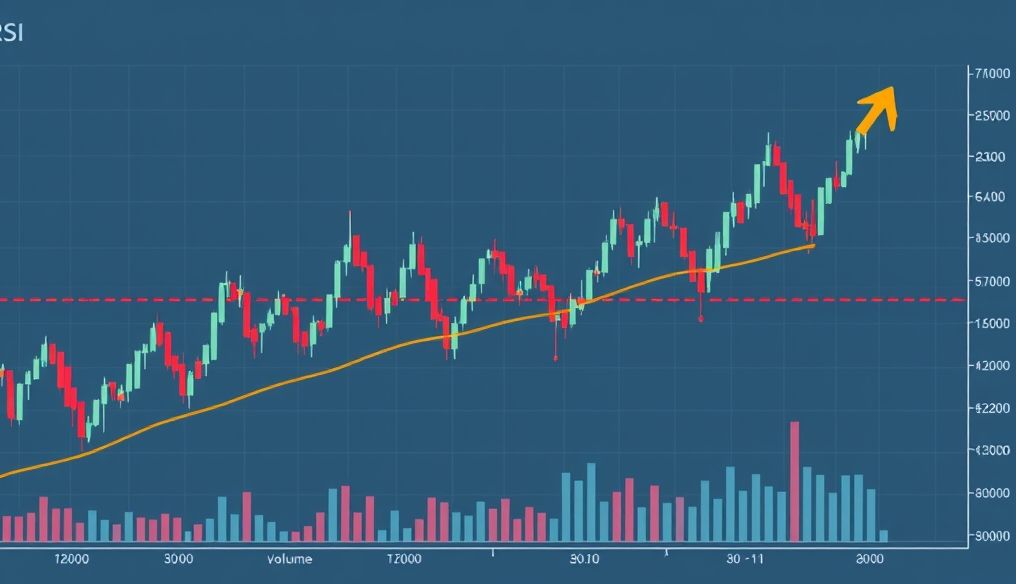Introduction to the Relative Strength Index (RSI)
The Relative Strength Index (RSI) is a momentum oscillator used in technical analysis to assess whether an asset is in overbought or oversold conditions. It was developed by J. Welles Wilder Jr. and published in his book "New Concepts in Technical Trading Systems" in 1978. The RSI ranges from 0 to 100, and it is typically considered overbought when above 70 and oversold when below 30.
Why is the RSI a Valuable Tool for Traders?
- Identifying Overbought and Oversold Conditions: Helps determine when an asset is overvalued or undervalued, potentially signaling an upcoming reversal.
- Confirming Trends: Can be used to confirm the strength of the current trend.
- Spotting Divergences: Divergence between price action and the RSI can indicate a potential trend reversal.
- Simple and Easy to Understand: Easy to understand and interpret, making it suitable for both novice and experienced traders.
Calculating the Relative Strength Index (RSI)
The RSI is calculated using the following formula:
RSI = 100 - (100 / (1 + RS))Where:
- RS (Relative Strength) = Average Gain / Average Loss over a specified period.
The RSI is typically calculated using a 14-period (usually 14 days) timeframe, but traders can adjust this period according to their strategy and time horizon.
Steps to Calculate the RSI:
- Calculate Gains and Losses: For each period, determine whether the price has increased (gain) or decreased (loss).
- Calculate Average Gains and Losses: Calculate the average gain and average loss over the specified period (usually 14 days).
- Calculate Relative Strength (RS): Divide the average gain by the average loss.
- Calculate RSI: Use the formula above to calculate the RSI value.
Interpreting RSI Signals
Overbought and Oversold Levels
As mentioned earlier, an RSI reading above 70 is generally considered a sign of overbought conditions, suggesting that the price may be overvalued and likely to decline. Conversely, an RSI reading below 30 is generally considered a sign of oversold conditions, suggesting that the price may be undervalued and likely to rise.
Example: If Saudi Aramco's stock is trading at high levels and its RSI is above 70, it might be a signal for traders to consider selling the stock or reducing their long positions.
Divergences
Divergences occur when the price and the RSI move in opposite directions. There are two main types of divergences:
- Bullish Divergence: Occurs when the price makes lower lows, while the RSI makes higher lows. This suggests that the downtrend may be weakening and the price may rise soon.
- Bearish Divergence: Occurs when the price makes higher highs, while the RSI makes lower highs. This suggests that the uptrend may be weakening and the price may decline soon.
Example: If the Dubai Financial Market Index is making higher highs, but the RSI is making lower highs, it might be a signal that the uptrend is losing momentum and a correction may be imminent.
Swing Failures
A swing failure is an RSI pattern that indicates a potential trend reversal. It occurs when the RSI breaks above an overbought or oversold level and then fails to reach that level again. Swing failures can be bullish or bearish.
Using RSI with Other Technical Indicators
To improve the accuracy of RSI signals, traders often use the RSI in conjunction with other technical indicators, such as:
- Moving Averages: Moving averages can be used to confirm the overall trend and identify areas of support and resistance.
- Trendlines: Trendlines can be used to identify the prevailing trend and confirm RSI signals.
- Volume: Volume can be used to confirm the strength of the trend and identify potential divergences.
- MACD: The MACD can be used to confirm RSI signals and identify potential crossovers.
Example: A trader might use the 200-day moving average to determine the overall trend of a stock. If the stock is trading above the 200-day moving average and the RSI is indicating oversold conditions, it could be a strong buy signal.
Advanced Trading Strategies Using RSI
Double Divergence Strategy
This strategy relies on identifying double divergences between the price and the RSI. Double divergences occur when the price makes lower lows (or higher highs) twice in a row, while the RSI makes higher lows (or lower highs) twice in a row. This strategy is considered more reliable than single divergences.
Swing Failure Strategy with Volume Confirmation
This strategy combines swing failures with volume confirmation. If a bullish swing failure occurs and is accompanied by an increase in volume, it could be a strong buy signal. Conversely, if a bearish swing failure occurs and is accompanied by an increase in volume, it could be a strong sell signal.
RSI with Bollinger Bands Strategy
This strategy combines the RSI with Bollinger Bands. When the RSI is in overbought territory and the price touches the upper Bollinger Band, it could be a sell signal. When the RSI is in oversold territory and the price touches the lower Bollinger Band, it could be a buy signal.
Risk Management When Using RSI
As with any trading strategy, it is essential to manage risk carefully when using the RSI. Some risk management tips include:
- Using Stop-Loss Orders: Place stop-loss orders to protect your capital in case the price moves against you.
- Position Sizing: Do not risk more than a small percentage of your capital on any single trade.
- Diversification: Diversify your portfolio across a variety of assets to reduce overall risk.
- Regular Review: Review your trading strategies regularly and adjust them as needed.
Common Mistakes to Avoid When Using RSI
There are some common mistakes that traders make when using the RSI. Avoiding these mistakes can significantly improve your trading results:
- Relying on RSI Alone: Do not rely on the RSI alone to make trading decisions. Use it in conjunction with other technical indicators and fundamental analysis tools.
- Ignoring the Overall Trend: Do not trade against the overall trend. If the trend is up, look for buying opportunities. If the trend is down, look for selling opportunities.
- Not Adjusting RSI Parameters: Adjust the RSI parameters (such as the time period) to suit the market and the asset you are trading.
- Trading Emotionally: Do not let emotions influence your trading decisions. Stick to your plan and be disciplined.
Practical Examples from the Arab Market
Let's take a look at some practical examples of how the RSI can be used in the Arab market:
- SABIC Stock: Traders can use the RSI to identify potential buying and selling opportunities in SABIC's stock. For example, if the RSI is indicating oversold conditions and the stock is approaching a support area, it could be a buy signal.
- TASI Index: Traders can use the RSI to analyze the overall trend of the TASI index and identify potential divergences that may signal a trend reversal.
- Saudi Riyal (SAR): Forex traders can use the RSI to identify potential trading opportunities in the Saudi Riyal against other currencies.
Conclusion: Mastering the Relative Strength Index (RSI)
The Relative Strength Index (RSI) is a powerful tool that can help traders make more informed trading decisions. However, it is important to remember that the RSI is not perfect and should be used in conjunction with other technical indicators and fundamental analysis tools. By understanding how to calculate the RSI, interpret its signals, and manage risk carefully, you can increase your chances of success in the financial markets.
Additional Resources for Learning More About RSI
- Books: "New Concepts in Technical Trading Systems" by J. Welles Wilder Jr.
- Websites: Investopedia, TradingView, BabyPips.
- Training Courses: Many online training courses are available to teach how to use the RSI in trading.



